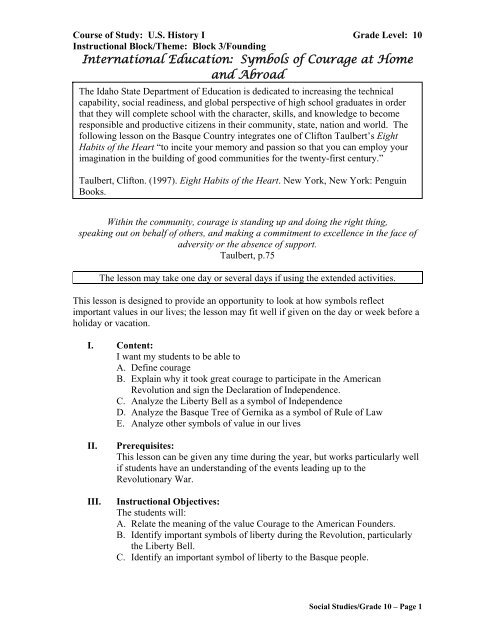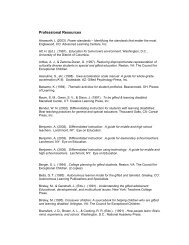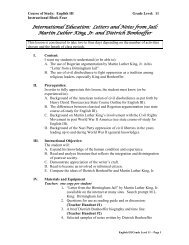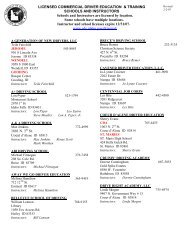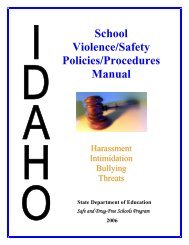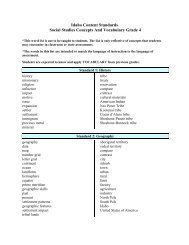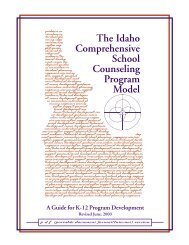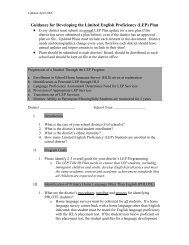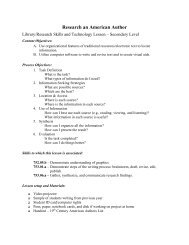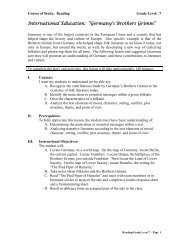US History I - Grade level 10 - Basque Country - Idaho State ...
US History I - Grade level 10 - Basque Country - Idaho State ...
US History I - Grade level 10 - Basque Country - Idaho State ...
You also want an ePaper? Increase the reach of your titles
YUMPU automatically turns print PDFs into web optimized ePapers that Google loves.
Course of Study: U.S. <strong>History</strong> I <strong>Grade</strong> Level: <strong>10</strong><br />
Instructional Block/Theme: Block 3/Founding<br />
International Education: Symbols of Courage at Home<br />
and Abroad<br />
The <strong>Idaho</strong> <strong>State</strong> Department of Education is dedicated to increasing the technical<br />
capability, social readiness, and global perspective of high school graduates in order<br />
that they will complete school with the character, skills, and knowledge to become<br />
responsible and productive citizens in their community, state, nation and world. The<br />
following lesson on the <strong>Basque</strong> <strong>Country</strong> integrates one of Clifton Taulbert’s Eight<br />
Habits of the Heart “to incite your memory and passion so that you can employ your<br />
imagination in the building of good communities for the twenty-first century.”<br />
Taulbert, Clifton. (1997). Eight Habits of the Heart. New York, New York: Penguin<br />
Books.<br />
Within the community, courage is standing up and doing the right thing,<br />
speaking out on behalf of others, and making a commitment to excellence in the face of<br />
adversity or the absence of support.<br />
Taulbert, p.75<br />
The lesson may take one day or several days if using the extended activities.<br />
This lesson is designed to provide an opportunity to look at how symbols reflect<br />
important values in our lives; the lesson may fit well if given on the day or week before a<br />
holiday or vacation.<br />
I. Content:<br />
I want my students to be able to<br />
A. Define courage<br />
B. Explain why it took great courage to participate in the American<br />
Revolution and sign the Declaration of Independence.<br />
C. Analyze the Liberty Bell as a symbol of Independence<br />
D. Analyze the <strong>Basque</strong> Tree of Gernika as a symbol of Rule of Law<br />
E. Analyze other symbols of value in our lives<br />
II.<br />
III.<br />
Prerequisites:<br />
This lesson can be given any time during the year, but works particularly well<br />
if students have an understanding of the events leading up to the<br />
Revolutionary War.<br />
Instructional Objectives:<br />
The students will:<br />
A. Relate the meaning of the value Courage to the American Founders.<br />
B. Identify important symbols of liberty during the Revolution, particularly<br />
the Liberty Bell.<br />
C. Identify an important symbol of liberty to the <strong>Basque</strong> people.<br />
Social Studies/<strong>Grade</strong> <strong>10</strong> – Page 1
Course of Study: U.S. <strong>History</strong> I <strong>Grade</strong> Level: <strong>10</strong><br />
Instructional Block/Theme: Block 3/Founding<br />
International Education: Symbols of Courage at Home<br />
and Abroad<br />
D. Interpret modern examples of courage and reassess their definition of<br />
courage.<br />
E. Apply an understanding of courage to their own lives and actions.<br />
IV.<br />
Materials and Equipment:<br />
Teacher: Lesson Packet<br />
Teacher Handout 1 – Liberty Bell<br />
Teacher Handout 2 – Tree of Gernika<br />
Teacher Handout 3 – Martin Luther King’s speech<br />
Student:<br />
Student Handout 1A – Courage Quotes<br />
Student Handout 1B – Focus Questions<br />
Student Handout 2 – <strong>Basque</strong> <strong>Country</strong> Map<br />
Student Handout 3 – Connection to <strong>Idaho</strong><br />
Student Handout 4A – Liberty Bell<br />
Student Handout 4B – Tree of Gernika (<strong>Basque</strong> <strong>Country</strong>,<br />
Spain)<br />
V. Instructional Procedure:<br />
A. Introduce students to lesson with Student Handout 1A - Courage Quotes.<br />
B. Have students read the quotes and make written responses as homework<br />
(Student Handouts 1A and 1B).<br />
C. Have students choose an historical narrative with which to respond.<br />
(Optional)<br />
D. Discuss the following with students:<br />
1. Have students share homework responses with class.<br />
2. Reach a consensus about a definition of courage.<br />
3. Ask students to think about the signers of the Declaration of<br />
Independence. Did these men act with courage? Why?<br />
4. Ask students to think about other people and circumstances in<br />
American history where people acted with courage, including<br />
current events.<br />
5. Ask students to think about an American symbol that may<br />
represent the courage of the Founders in signing the Declaration of<br />
Independence. (Students may come with several symbols.)<br />
6. Tell them you will focus on the Liberty Bell.<br />
7. Show the students a picture of the Liberty Bell (Teacher Handout<br />
1 or they can get a picture off the web site:<br />
http://www.ushistory.org/libertybell). Inform students that other<br />
symbols of Liberty exist around the world. Show the students a<br />
picture of the tree of Gernika (Teacher Handout 2 or they can get<br />
a picture off the web site:<br />
http://www.jjggbizkaia.net/english/casa_juntas/arbol_gernika.asp).<br />
Social Studies/<strong>Grade</strong> <strong>10</strong> – Page 2
Course of Study: U.S. <strong>History</strong> I <strong>Grade</strong> Level: <strong>10</strong><br />
Instructional Block/Theme: Block 3/Founding<br />
International Education: Symbols of Courage at Home<br />
and Abroad<br />
8. Divide the students into two groups. Give one group Student<br />
Handout 4A – Information on the Liberty Bell. Have them read it<br />
and prepare to share information with another student. Give the<br />
other group of students Student Handout 4B - Information on the<br />
history of the Tree of Gernika. Have them read and prepare to<br />
discuss with another student.<br />
Peer teaching gives an opportunity for students to learn information in two or more<br />
separate groups and then be paired with someone from the other group to teach about<br />
his/her information. This ensures the student understand the material by first reading and<br />
discussing it with others and then presenting it to another student.<br />
Once students have taught each other about their group’s symbol, put them into groups of<br />
three and have each group prepare a picture of something that symbolizes courage to<br />
them. (Pictures may be individual drawings, clip art, or magazine pictures, depending on<br />
the individual strength of the group members.)<br />
Cooperative learning allows students an opportunity to work together with others<br />
promoting citizenship in a group activity and learning responsibility for individual tasks.<br />
Have students share their new symbols with the group.<br />
VI.<br />
Assessment/Evaluation:<br />
Students will share knowledge of Independence symbols with each other in<br />
pairs. Students will share their own Courage symbols with each other,<br />
explaining why they chose them.<br />
A. Ask students whether their definition of courage has changed as a result of<br />
this lesson.<br />
B. Ask students (again) to think of times when they might act courageously.<br />
VII.<br />
<strong>Idaho</strong> Achievement Standards:<br />
6-12.<strong>US</strong>H1.1.1.1: Compare and contrast the different cultural and social<br />
influences that emerged in the North American<br />
colonies.<br />
6-12.<strong>US</strong>H1.1.1.3: Analyze the common traits, beliefs, and characteristics<br />
that unite the United <strong>State</strong>s as a nation and a society.<br />
6-12.<strong>US</strong>H1.1.2.1: Analyze the religious, political, and economic motives<br />
of European immigrants who came to North America.<br />
6-12.<strong>US</strong>H1.4.1.2: Identify fundamental values and principles as expressed<br />
in basic documents such as the Declaration of<br />
Independence, Articles of Confederation, and the<br />
United <strong>State</strong>s Constitution.<br />
6-12.<strong>US</strong>H1.4.3.1: Provide and evaluate examples of social and political<br />
leadership in early American history.<br />
Social Studies/<strong>Grade</strong> <strong>10</strong> – Page 3
Course of Study: U.S. <strong>History</strong> I <strong>Grade</strong> Level: <strong>10</strong><br />
Instructional Block/Theme: Block 3/Founding<br />
International Education: Symbols of Courage at Home<br />
and Abroad<br />
6-12.<strong>US</strong>H1.4.4.1: Trace the development of constitutional democracy in<br />
the United <strong>State</strong>s, such as the Mayflower Compact,<br />
colonial assemblies, Bacon’s Rebellion.<br />
VIII. Follow Up or Extension Activities:<br />
A. Declaration of Independence Activity<br />
B. Study Martin Luther King’s speech – Teacher Handout 3. Discuss or<br />
write a response to how King used courage when proclaiming liberty in<br />
his “I Have a Dream” speech.<br />
C. Study Douglas’s quote on liberty. Discuss or write a response.<br />
D. Play the song, “If I Had a Hammer.”<br />
E. Discuss or write a response to symbolism used in the song.<br />
F. Study Governor Kempthorne’s Proclamation on Jaialdi Days.<br />
G. Discuss further the connection between <strong>Idaho</strong>’s <strong>Basque</strong> people and<br />
Spain’s <strong>Basque</strong> <strong>Country</strong>.<br />
H. Assign students to research other <strong>Basque</strong>s in America.<br />
I. Have students locate an article that illustrates a contemporary American<br />
acting courageously to defend American rights, and then write a oneparagraph<br />
response.<br />
J. President Andrew Jackson said, “One man with courage makes a<br />
majority.” Using examples from American history, have students write a<br />
five-paragraph essay in which they agree or disagree with this statement.<br />
K. Write a three to five page research paper which focuses on the acts of a<br />
person in American history who has courageously defended individual<br />
liberties and rights against the will of the majority.<br />
Social Studies/<strong>Grade</strong> <strong>10</strong> – Page 4
Teacher Handout 1<br />
Liberty Bell<br />
Social Studies/<strong>Grade</strong> <strong>10</strong> – Page 5
Teacher Handout 2<br />
Tree of Gernika<br />
Social Studies/<strong>Grade</strong> <strong>10</strong> – Page 6
Teacher Handout 3<br />
http://www.mecca.org/~crights/dream.html<br />
"I Have A Dream"<br />
by Martin Luther King, Jr,<br />
Delivered on the steps at the Lincoln Memorial in Washington D.C. on August 28, 1963.<br />
Source: Martin Luther King, Jr: The Peaceful Warrior, Pocket Books, NY 1968<br />
Five score years ago, a great American, in whose symbolic shadow we stand<br />
signed the Emancipation Proclamation. This momentous decree came as a great<br />
beacon light of hope to millions of Negro slaves who had been seared in the<br />
flames of withering injustice. It came as a joyous daybreak to end the long<br />
night of captivity. But one hundred years later, we must face the tragic fact that<br />
the Negro is still not free.<br />
One hundred years later, the life of the Negro is still sadly crippled by the<br />
manacles of segregation and the chains of discrimination. One hundred years<br />
later, the Negro lives on a lonely island of poverty in the midst of a vast ocean<br />
of material prosperity. One hundred years later, the Negro is still languishing in<br />
the corners of American society and finds himself an exile in his own land.<br />
So we have come here today to dramatize an appalling condition. In a sense<br />
we have come to our nation's capital to cash a check. When the architects of<br />
our republic wrote the magnificent words of the Constitution and the<br />
Declaration of Independence, they were signing a promissory note to which<br />
every American was to fall heir.<br />
This note was a promise that all men would be guaranteed the inalienable<br />
rights of life, liberty, and the pursuit of happiness. It is obvious today that<br />
America has defaulted on this promissory note insofar as her citizens of color<br />
are concerned. Instead of honoring this sacred obligation, America has given<br />
the Negro people a bad check which has come back marked "insufficient<br />
funds." But we refuse to believe that the bank of justice is bankrupt. We refuse<br />
to believe that there are insufficient funds in the great vaults of opportunity of<br />
this nation.<br />
Social Studies/<strong>Grade</strong> <strong>10</strong> – Page 7
Teacher Handout 3<br />
So we have come to cash this check -- a check that will give us upon demand<br />
the riches of freedom and the security of justice. We have also come to this<br />
hallowed spot to remind America of the fierce urgency of now. This is no time<br />
to engage in the luxury of cooling off or to take the tranquilizing drug of<br />
gradualism. Now is the time to rise from the dark and desolate valley of<br />
segregation to the sunlit path of racial justice. Now is the time to open the doors<br />
of opportunity to all of God's children. Now is the time to lift our nation from<br />
the quicksands of racial injustice to the solid rock of brotherhood.<br />
It would be fatal for the nation to overlook the urgency of the moment and to<br />
underestimate the determination of the Negro. This sweltering summer of the<br />
Negro's legitimate discontent will not pass until there is an invigorating autumn<br />
of freedom and equality. Nineteen sixty-three is not an end, but a beginning.<br />
Those who hope that the Negro needed to blow off steam and will now be<br />
content will have a rude awakening if the nation returns to business as usual.<br />
There will be neither rest nor tranquility in America until the Negro is granted<br />
his citizenship rights.<br />
The whirlwinds of revolt will continue to shake the foundations of our nation<br />
until the bright day of justice emerges. But there is something that I must say to<br />
my people who stand on the warm threshold which leads into the palace of<br />
justice. In the process of gaining our rightful place we must not be guilty of<br />
wrongful deeds. Let us not seek to satisfy our thirst for freedom by drinking<br />
from the cup of bitterness and hatred.<br />
We must forever conduct our struggle on the high plane of dignity and<br />
discipline. we must not allow our creative protest to degenerate into physical<br />
violence. Again and again we must rise to the majestic heights of meeting<br />
physical force with soul force.<br />
The marvelous new militancy which has engulfed the Negro community must<br />
not lead us to distrust of all white people, for many of our white brothers, as<br />
evidenced by their presence here today, have come to realize that their destiny<br />
is tied up with our destiny and their freedom is inextricably bound to our<br />
freedom.<br />
Social Studies/<strong>Grade</strong> <strong>10</strong> – Page 8
Teacher Handout 3<br />
We cannot walk alone. And as we walk, we must make the pledge that we<br />
shall march ahead. We cannot turn back. There are those who are asking the<br />
devotees of civil rights, "When will you be satisfied?" we can never be satisfied<br />
as long as our bodies, heavy with the fatigue of travel, cannot gain lodging in<br />
the motels of the highways and the hotels of the cities. We cannot be satisfied<br />
as long as the Negro's basic mobility is from a smaller ghetto to a larger one.<br />
We can never be satisfied as long as a Negro in Mississippi cannot vote and a<br />
Negro in New York believes he has nothing for which to vote. No, no, we are<br />
not satisfied, and we will not be satisfied until justice rolls down like waters<br />
and righteousness like a mighty stream.<br />
I am not unmindful that some of you have come here out of great trials and<br />
tribulations. Some of you have come fresh from narrow cells. Some of you<br />
have come from areas where your quest for freedom left you battered by the<br />
storms of persecution and staggered by the winds of police brutality. You have<br />
been the veterans of creative suffering. Continue to work with the faith that<br />
unearned suffering is redemptive.<br />
Go back to Mississippi, go back to Alabama, go back to Georgia, go back to<br />
Louisiana, go back to the slums and ghettos of our northern cities, knowing that<br />
somehow this situation can and will be changed. Let us not wallow in the<br />
valley of despair. I say to you today, my friends, that in spite of the difficulties<br />
and frustrations of the moment, I still have a dream. It is a dream deeply rooted<br />
in the American dream.<br />
I have a dream that one day this nation will rise up and live out the true<br />
meaning of its creed: "We hold these truths to be self-evident: that all men are<br />
created equal." I have a dream that one day on the red hills of Georgia the sons<br />
of former slaves and the sons of former slaveowners will be able to sit down<br />
together at a table of brotherhood. I have a dream that one day even the state of<br />
Mississippi, a desert state, sweltering with the heat of injustice and oppression,<br />
will be transformed into an oasis of freedom and justice. I have a dream that my<br />
four children will one day live in a nation where they will not be judged by the<br />
color of their skin but by the content of their character. I have a dream today.<br />
I have a dream that one day the state of Alabama, whose governor's lips are<br />
presently dripping with the words of interposition and nullification, will be<br />
transformed into a situation where little black boys and black girls will be able<br />
Social Studies/<strong>Grade</strong> <strong>10</strong> – Page 9
Teacher Handout 3<br />
to join hands with little white boys and white girls and walk together as sisters<br />
and brothers. I have a dream today. I have a dream that one day every valley<br />
shall be exalted, every hill and mountain shall be made low, the rough places<br />
will be made plain, and the crooked places will be made straight, and the glory<br />
of the Lord shall be revealed, and all flesh shall see it together. This is our<br />
hope. This is the faith with which I return to the South. With this faith we will<br />
be able to hew out of the mountain of despair a stone of hope. With this faith<br />
we will be able to transform the jangling discords of our nation into a beautiful<br />
symphony of brotherhood. With this faith we will be able to work together, to<br />
pray together, to struggle together, to go to jail together, to stand up for<br />
freedom together, knowing that we will be free one day.<br />
This will be the day when all of God's children will be able to sing with a new<br />
meaning, "My country, 'tis of thee, sweet land of liberty, of thee I sing. Land<br />
where my fathers died, land of the pilgrim's pride, from every mountainside, let<br />
freedom ring." And if America is to be a great nation, this must become true.<br />
So let freedom ring from the prodigious hilltops of New Hampshire. Let<br />
freedom ring from the mighty mountains of New York. Let freedom ring from<br />
the heightening Alleghenies of Pennsylvania! Let freedom ring from the<br />
snowcapped Rockies of Colorado! Let freedom ring from the curvaceous peaks<br />
of California! But not only that; let freedom ring from Stone Mountain of<br />
Georgia! Let freedom ring from Lookout Mountain of Tennessee! Let freedom<br />
ring from every hill and every molehill of Mississippi. From every<br />
mountainside, let freedom ring.<br />
When we let freedom ring, when we let it ring from every village and every<br />
hamlet, from every state and every city, we will be able to speed up that day<br />
when all of God's children, black men and white men, Jews and Gentiles,<br />
Protestants and Catholics, will be able to join hands and sing in the words of<br />
the old Negro spiritual, "Free at last! free at last! thank God Almighty, we are<br />
free at last!"<br />
Social Studies/<strong>Grade</strong> <strong>10</strong> – Page <strong>10</strong>
Student Handout 1A<br />
COURAGE<br />
The gods looked with favour on superior courage.<br />
-Tacitus, Roman historian<br />
The harder the conflict, the more glorious the triumph.<br />
What we obtain too cheap, we esteem too lightly;<br />
It is dearness only that gives everything its value.<br />
I love the man that can smile in trouble,<br />
That can gather strength from distress and grow brave by reflection.<br />
‘Tis the business of little minds to shrink: but he whose heart is firm,<br />
and whose conscience approves his conduct,<br />
will pursue his principles unto death.<br />
-Thomas Paine, American patriot<br />
Courage is doing what you’re afraid to do.<br />
There can be no courage unless you’re scared.<br />
-Eddie Rickenbacker, American WWI hero<br />
Courage is not simply one of the virtues,<br />
But the form of every virtue at the testing point.<br />
-C.S. Lewis, British author<br />
Being deeply loved by someone gives you strength;<br />
Loving someone deeply gives you courage.<br />
-Lao-Tzu, Chinese philosopher<br />
One man with courage makes a majority.<br />
-Andrew Jackson, 7 th President of the United <strong>State</strong>s<br />
Courage is of the heart by derivation. But fear is of the soul.<br />
-Robert Frost, American poet<br />
-Bill of Rights Institute, Citizenship and Character<br />
Social Studies/<strong>Grade</strong> <strong>10</strong> – Page 11
Student Handout 1B<br />
COURAGE FOC<strong>US</strong> QUESTIONS<br />
1. When you think of the word “courage,” what comes to your mind?<br />
2. Are there different types of courage? Can you give specific examples?<br />
3. Have you – or has someone you know – ever acted courageously? What<br />
happened? Describe the situation.<br />
4. Which historical figures do you remember as having acted with courage?<br />
5. Is it easier to act courageously in some circumstances than in others? Explain.<br />
6. In the future, what kinds of situations might inspire you to act with courage?<br />
7. Does courage always require a noble objective (e.g., can a Nazi officer who was<br />
awarded the German awards for valor and gallantry be considered courageous)?<br />
Explain.<br />
8. Does it take courage to stand up for your rights? Why?<br />
Social Studies/<strong>Grade</strong> <strong>10</strong> – Page 12
Student Handout 1B – ANSWERS TO COURAGE FOC<strong>US</strong> QUESTIONS<br />
COURAGE FOC<strong>US</strong> QUESTIONS<br />
(With Answers)<br />
1. When you think of the word “courage,” what comes to your mind?<br />
E.G. bravery, strength, standing up to adversity, despite fear<br />
2. Are there different types of courage? Can you give specific examples?<br />
Different types of courage would include physical, intellectual,<br />
moral, or ethical courage. Physical courage is exemplified by<br />
the person who risks her life and physical well-being for the sake<br />
of others (e.g., a member of the military); intellectual courage is<br />
typified by the individual who holds on to an unpopular idea or<br />
theory; and moral or ethical courage is demonstrated by<br />
someone who holds true to a belief or value in light of challenges<br />
and adversity.<br />
3. Have you – or has someone you know – ever acted courageously? What<br />
happened? Describe the situation.<br />
Answers will vary. Encourage the students to think of examples of<br />
all types of courage.<br />
4. Which historical figures do you remember as having acted with courage?<br />
E.g., physical courage: athletes, soldiers, adventurers;<br />
intellectual courage: scientists (e.g., Galileo, Einstein);<br />
moral or ethical courage: abolitionists, civil rights workers<br />
5. Is it easier to act courageously in some circumstances than in others? Explain.<br />
Answers will vary.<br />
6. In the future, what kinds of situations might inspire you to act with courage?<br />
E.g., helping a friend in need; resisting peer pressure; preventing<br />
the commission of a crime; serving in the military; standing up for<br />
an unpopular principle or belief; supporting a political cause.<br />
7. Does courage always require a noble objective (e.g., can a Nazi officer who was<br />
awarded the German awards for valor and gallantry be considered courageous)?<br />
Explain.<br />
Answers will vary.<br />
8. Does it take courage to stand up for your rights? Why?<br />
It takes courage to stand up for your rights. Rights are usually<br />
infringed upon by physically stronger individuals (e.g., a bully) or<br />
by a majority viewpoint (be it an intellectual or a moral<br />
perspective), and it is not easy to hold true to one’s positions or<br />
values when one is outmatched or outnumbered.<br />
Social Studies/<strong>Grade</strong> <strong>10</strong> – Page 13
Student Handout 2<br />
Social Studies/<strong>Grade</strong> <strong>10</strong> – Page 14
Student Handout 3<br />
Connection to <strong>Idaho</strong><br />
Background information on the <strong>Basque</strong>s in <strong>Idaho</strong><br />
This article is also available on the following website:<br />
http://www.boiseweekly.com/gyrobase/Content?oid=76832<br />
Posted on JULY 27, 2005:<br />
A SHORT BASQUE HISTORY<br />
By Bingo Barnes<br />
<strong>Idaho</strong> is home to one of the largest populations of <strong>Basque</strong>s outside of Spain. Numbers<br />
around 30,000 in southern <strong>Idaho</strong> and eastern Oregon are thrown around as estimates.<br />
They have been here about as long as western settlers have inhabited the region-since the<br />
mid to late 1800s-first coming for mining, then as shepherds. It was so nice, they invited<br />
their friends and family from the old continent.<br />
Stereotypically, the <strong>Basque</strong>s are known as a somewhat secretive culture, friendly and<br />
helpful to strangers and outsiders, hard working and industrious, but content to keep to<br />
themselves. To understand the <strong>Basque</strong> way of life in the West-one filled with tradition<br />
and a sharp sense of history- it is important to understand their culture and the history that<br />
defines them.<br />
In A <strong>Basque</strong> <strong>History</strong> of the World, author Mark Kurlansky begins Chapter One by<br />
describing the <strong>Basque</strong>s as "a mythical people, almost an imagined people." It is<br />
somewhat true. The <strong>Basque</strong>s are the oldest living ethnic group on the European continent,<br />
yet have never managed to have a country of their own. Yet they have survived as a<br />
culture unlike others who long ago were assimilated into others after invaders swept<br />
across Europe, not once, but many times.<br />
The <strong>Basque</strong> country is made up of seven provinces occupying the corner of Europe where<br />
France meets Spain along the Atlantic coast. It is a region occupying just 8,218 square<br />
miles, slightly smaller than New Hampshire, slightly larger than Owyhee County.<br />
According to Nancy Zubiri, author of A Travel Guide to <strong>Basque</strong> America, almost 90<br />
percent of the <strong>Basque</strong>s in <strong>Idaho</strong> trace their heritage back to the Bizkaia (also spelled<br />
Viscaya) region, which includes the cities of Bilbao and Guernica.<br />
There are no early written records by <strong>Basque</strong>s, but when the Romans arrived in 218 B.C.<br />
they wrote about them as if they were already an ancient race with a clearly defined<br />
culture. There are unique characteristics-including language, physiological traits,<br />
geography and a skill in innovation-which have defined and protected the <strong>Basque</strong>s,<br />
allowing them to survive through 20 centuries.<br />
The <strong>Basque</strong> language is the only non-Aryan language in Europe and cannot be traced to<br />
any other linguistically similar tongue. Linguists believe it may be the oldest living<br />
European language. This mysterious language defined and separated them from the<br />
Latin-based romance language cultures.<br />
Social Studies/<strong>Grade</strong> <strong>10</strong> – Page 15
Student Handout 3<br />
<strong>Basque</strong>s are also distinct and unique in their physiological characteristics. These traits<br />
may have preserved the culture from the most successful form of invasion-assimilation.<br />
The <strong>Basque</strong> people have the highest concentration of O type blood in the world and the<br />
highest concentration of Rh negative type blood of any people. While modern medicine<br />
can prevent this today, historically, women with O-negative blood miscarried when their<br />
fetuses had Rh-positive blood.<br />
Geography protected the <strong>Basque</strong> culture, too. The <strong>Basque</strong> country straddles the Pyrenees<br />
Mountains separating France and Spain. This land is not suited to farming and is<br />
undesirable to invaders, but has often been used by invading armies passing through. The<br />
<strong>Basque</strong>s were fine with people passing through their lands, but when the travellers<br />
stopped, it wasn't copacetic.<br />
Armies encountered fierce resistance from a people that could assemble quickly, fight,<br />
then disappear into the rugged countryside. No invading army was ever able to conquer<br />
the <strong>Basque</strong>s.<br />
The <strong>Basque</strong>s also were great shipbuilders, relying on the riches from the sea to not only<br />
feed their people, but provide dried fish and whale meat to other kingdoms throughout<br />
the middle ages. Their voyages followed whales to their summer feeding grounds in the<br />
arctic, and some historians believe the <strong>Basque</strong>s may have discovered America and its rich<br />
fishing grounds long before Columbus. During the age of discovery, any Spanish or<br />
Portuguese vessel of any acclaim-from Columbus's Santa Maria to Magellan's<br />
circumnavigation of the world-had <strong>Basque</strong> sailors on board and were perhaps<br />
commanded and even built by <strong>Basque</strong>s. There is evidence that <strong>Basque</strong>s may have<br />
invented armor plating for ships and a ship powered by steam, centuries before they<br />
showed up elsewhere.<br />
The first <strong>Basque</strong>s in <strong>Idaho</strong> showed up as miners in the 1880s and 1890s, quickly turning<br />
to sheep herding as a means of a living. These <strong>Basque</strong>s wrote home and invited their<br />
friends and family who came in large numbers between 1900 and 1920. Today, there are<br />
many <strong>Basque</strong> celebrations around the West. In Reno, Elko, Las Vegas, Salt Lake City<br />
and in numerous small towns, picnics, festivals and celebrations, the <strong>Basque</strong>s come<br />
together, even from overseas. This tightly knit community continues to celebrate its own<br />
culture and welcomes others to join in.<br />
Social Studies/<strong>Grade</strong> <strong>10</strong> – Page 16
Student Handout 4A<br />
LIBERTY BELL<br />
(<strong>US</strong>A)<br />
“The Liberty Bell is “a very significant symbol for the entire democratic world.”<br />
-Nelson Mandela, Philadelphia Inquirer, July 4, 1993<br />
In 1751, the Pennsylvania Assembly ordered the Liberty Bell to commemorate the<br />
50-year anniversary of William Penn’s 1701 Charter of Privileges. Pennsylvania’s<br />
original constitution speaks of the rights and freedoms valued by people the world over<br />
with Penn’s ideas on religious freedom, his stance on Native American rights, and his<br />
desire to include citizens when creating laws.<br />
Since the bell was to commemorate the Charter’s golden anniversary, a special<br />
quotation was included on it: “Proclaim Liberty throughout all the land unto all the<br />
inhabitants thereof,” from Leviticus 25:<strong>10</strong>. A line in the Bible right before the phrase<br />
“proclaim liberty” is, “And ye shall hallow the fiftieth year.” Many saw the Bell<br />
proclaiming liberty as the perfect way to celebrate Penn and the golden anniversary.<br />
The Liberty Bell was rung to call the Assembly together and to notify<br />
townspeople of upcoming events and special announcements. One historic occasion<br />
when the bell tolled included when Benjamin Franklin was sent to England to address<br />
Colonial grievances. It also tolled when King George III ascended to the throne in 1761,<br />
in 1764 to call the people of Philadelphia together to discuss the Sugar Act, and in 1765<br />
to discuss the Stamp Act.<br />
The bell continued to toll in 1774 for the First Continental Congress, in 1775 for<br />
the Battle of Lexington and Concord, and on July 8, 1775, when it called the citizens of<br />
Philadelphia together for the reading of the Declaration of Independence produced by the<br />
Second Continental Congress.<br />
From 1790 to 1800, the Bell was used to call the state legislature into session, to<br />
summon voters to hand in their ballots at the <strong>State</strong> House window, to commemorate<br />
Washington’s birthday and to celebrate the Fourth of July.<br />
Social Studies/<strong>Grade</strong> <strong>10</strong> – Page 17
Student Handout 4A<br />
Abolitionists adopted the Liberty Bell as a symbol for their movement and it was<br />
included in an abolitionist pamphlet, which was the first documented use of the name,<br />
“Liberty Bell.”<br />
Starting in the 1880s, the Bell traveled to cities throughout the land “proclaiming<br />
liberty” and inspiring the cause of freedom.<br />
On every Fourth of July, at 2 pm Eastern time, children who are descendants of<br />
signers of the Declaration of Independence symbolically tap the Liberty Bell 13 times<br />
while bells across the nation also ring 13 times in honor of the patriots from the original<br />
13 states.<br />
www.ushistory.org/liberty bell<br />
Social Studies/<strong>Grade</strong> <strong>10</strong> – Page 18
Student Handout 4B<br />
STUDENT HANDOUT 4B<br />
TREE OF GERNIKA<br />
(<strong>Basque</strong> <strong>Country</strong>, Spain)<br />
The Tree of<br />
Gernika<br />
is blessed<br />
and very<br />
much loved<br />
among the <strong>Basque</strong>s.<br />
Give and extend<br />
your fruit around the world<br />
We<br />
Venerate<br />
you<br />
Holy Tree<br />
among the <strong>Basque</strong>s.<br />
Give and<br />
extend<br />
your fruit<br />
around the world<br />
We<br />
Venerate<br />
you<br />
Holy Tree.<br />
(A hymn composed by Iparragirre and sung by millions of <strong>Basque</strong>s around the world<br />
in honor of the Tree of Gernika.)<br />
As the most universal symbol of all <strong>Basque</strong> people, the Tree of Gernika has<br />
become a reference for all the <strong>Basque</strong> <strong>Country</strong> as a symbol of democracy and proper<br />
government. It has witnessed many government related special events, such as the<br />
Social Studies/<strong>Grade</strong> <strong>10</strong> – Page 19
Student Handout 4B<br />
swearing into office of the President of the <strong>Basque</strong> <strong>Country</strong> and the Prime Minister of the<br />
Territory.<br />
In 1936, these words were used in the swearing in ceremony and have become the<br />
standard for swearing into office:<br />
Humbled before God<br />
On foot on <strong>Basque</strong> soil<br />
In memory of our ancestors<br />
Under the tree of Gernika<br />
Before you<br />
Representatives of the people<br />
I swear to faithfully carry out my duties.<br />
On the west lawn of the <strong>Idaho</strong> <strong>State</strong>house is an oak tree from the Tree of Gernika brought<br />
to <strong>Idaho</strong> in 1981 from the <strong>Basque</strong> <strong>Country</strong> as a symbol of <strong>Basque</strong> freedom and<br />
independence.<br />
Social Studies/<strong>Grade</strong> <strong>10</strong> – Page 20


